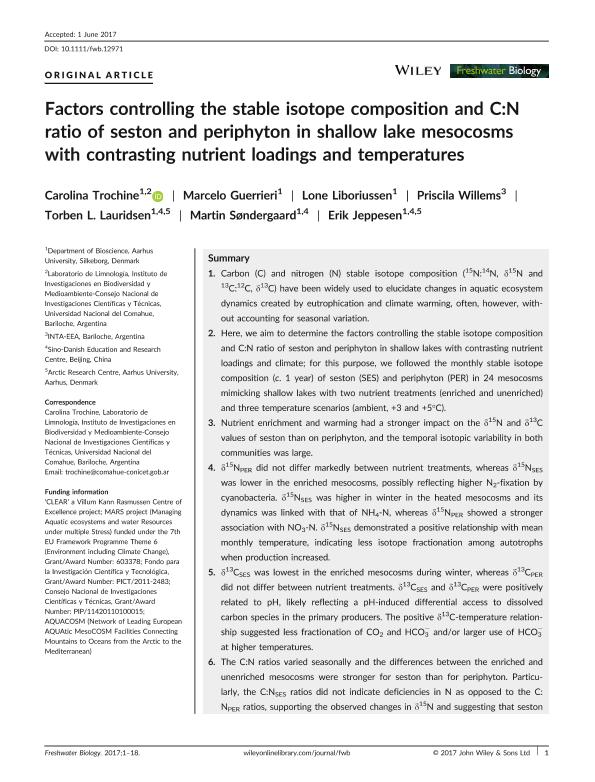Mostrar el registro sencillo del ítem
dc.contributor.author
Trochine, Carolina

dc.contributor.author
Guerrieri, Marcelo
dc.contributor.author
Liboriussen, Lone
dc.contributor.author
Willems, Priscila
dc.contributor.author
Lauridsen, Torben L.
dc.contributor.author
Søndergaard, Martín
dc.contributor.author
Jeppesen, Erik
dc.date.available
2018-11-06T18:27:02Z
dc.date.issued
2017-09
dc.identifier.citation
Trochine, Carolina; Guerrieri, Marcelo; Liboriussen, Lone; Willems, Priscila; Lauridsen, Torben L.; et al.; Factors controlling the stable isotope composition and C:N ratio of seston and periphyton in shallow lake mesocosms with contrasting nutrient loadings and temperatures; Wiley Blackwell Publishing, Inc; Freshwater Biology (print); 62; 9; 9-2017; 1596-1613
dc.identifier.issn
0046-5070
dc.identifier.uri
http://hdl.handle.net/11336/63789
dc.description.abstract
Carbon (C) and nitrogen (N) stable isotope composition (15N:14N, δ15N and 13C:12C, δ13C) have been widely used to elucidate changes in aquatic ecosystem dynamics created by eutrophication and climate warming, often, however, without accounting for seasonal variation. Here, we aim to determine the factors controlling the stable isotope composition and C:N ratio of seston and periphyton in shallow lakes with contrasting nutrient loadings and climate; for this purpose, we followed the monthly stable isotope composition (c. 1 year) of seston (SES) and periphyton (PER) in 24 mesocosms mimicking shallow lakes with two nutrient treatments (enriched and unenriched) and three temperature scenarios (ambient, +3 and +5°C). Nutrient enrichment and warming had a stronger impact on the δ15N and δ13C values of seston than on periphyton, and the temporal isotopic variability in both communities was large. δ15NPER did not differ markedly between nutrient treatments, whereas δ15NSES was lower in the enriched mesocosms, possibly reflecting higher N2-fixation by cyanobacteria. δ15NSES was higher in winter in the heated mesocosms and its dynamics was linked with that of NH4-N, whereas δ15NPER showed a stronger association with NO3-N. δ15NSES demonstrated a positive relationship with mean monthly temperature, indicating less isotope fractionation among autotrophs when production increased. δ13CSES was lowest in the enriched mesocosms during winter, whereas δ13CPER did not differ between nutrient treatments. δ13CSES and δ13CPER were positively related to pH, likely reflecting a pH-induced differential access to dissolved carbon species in the primary producers. The positive δ13C-temperature relationship suggested less fractionation of CO2 and HCO3 − and/or larger use of HCO3 − at higher temperatures. The C:N ratios varied seasonally and the differences between the enriched and unenriched mesocosms were stronger for seston than for periphyton. Particularly, the C:NSES ratios did not indicate deficiencies in N as opposed to the C:NPER ratios, supporting the observed changes in δ15N and suggesting that seston and periphyton have access to different sources of nutrients. We did not observe any clear effect of temperature warming on the C:N ratios. Our study provides evidence of strong seasonality in the isotopic composition and C:N ratios of seston and periphyton across nutrient and temperature levels; also, we identified several factors that are likely to modulate the strength and variability in stable isotopes values and stoichiometry of sestonic and periphytic communities under these scenarios.
dc.format
application/pdf
dc.language.iso
eng
dc.publisher
Wiley Blackwell Publishing, Inc

dc.rights
info:eu-repo/semantics/openAccess
dc.rights.uri
https://creativecommons.org/licenses/by-nc-sa/2.5/ar/
dc.subject
Carbon Stable Isotopes
dc.subject
Climate Warming
dc.subject
Eutrophication
dc.subject
Nitrogen Stable Isotopes
dc.subject
Primary Producers
dc.subject.classification
Otras Ciencias Biológicas

dc.subject.classification
Ciencias Biológicas

dc.subject.classification
CIENCIAS NATURALES Y EXACTAS

dc.title
Factors controlling the stable isotope composition and C:N ratio of seston and periphyton in shallow lake mesocosms with contrasting nutrient loadings and temperatures
dc.type
info:eu-repo/semantics/article
dc.type
info:ar-repo/semantics/artículo
dc.type
info:eu-repo/semantics/publishedVersion
dc.date.updated
2018-10-23T16:16:41Z
dc.journal.volume
62
dc.journal.number
9
dc.journal.pagination
1596-1613
dc.journal.pais
Reino Unido

dc.journal.ciudad
Londres
dc.description.fil
Fil: Trochine, Carolina. Consejo Nacional de Investigaciones Científicas y Técnicas. Centro Científico Tecnológico Conicet - Patagonia Norte. Instituto de Investigaciones en Biodiversidad y Medioambiente. Universidad Nacional del Comahue. Centro Regional Universidad Bariloche. Instituto de Investigaciones en Biodiversidad y Medioambiente; Argentina. University Aarhus; Dinamarca
dc.description.fil
Fil: Guerrieri, Marcelo. University Aarhus; Dinamarca
dc.description.fil
Fil: Liboriussen, Lone. University Aarhus; Dinamarca
dc.description.fil
Fil: Willems, Priscila. Instituto Nacional de Tecnología Agropecuaria. Centro Regional Patagonia Norte. Estación Experimental Agropecuaria San Carlos de Bariloche; Argentina
dc.description.fil
Fil: Lauridsen, Torben L.. University Aarhus; Dinamarca. Sino-Danish Education and Research Centre; China
dc.description.fil
Fil: Søndergaard, Martín. University Aarhus; Dinamarca. Sino-Danish Education and Research Centre; China
dc.description.fil
Fil: Jeppesen, Erik. University Aarhus; Dinamarca. Sino-Danish Education and Research Centre; China
dc.journal.title
Freshwater Biology (print)

dc.relation.alternativeid
info:eu-repo/semantics/altIdentifier/doi/http://dx.doi.org/10.1111/fwb.12971
dc.relation.alternativeid
info:eu-repo/semantics/altIdentifier/url/https://onlinelibrary.wiley.com/doi/abs/10.1111/fwb.12971
Archivos asociados
